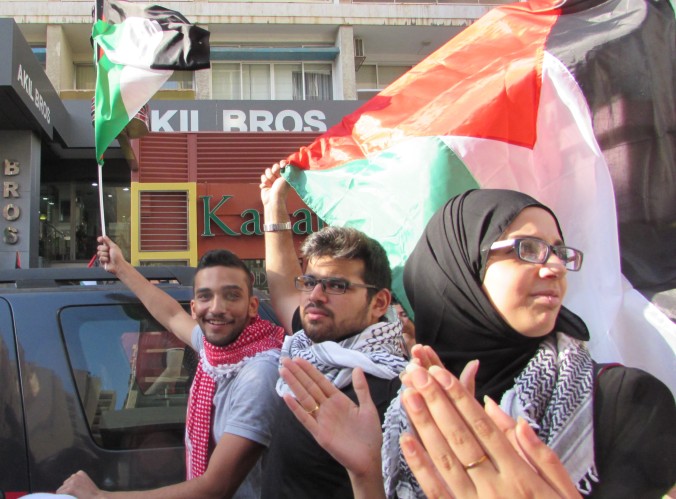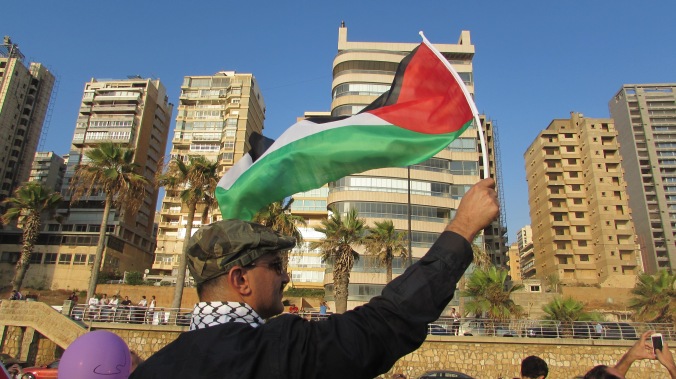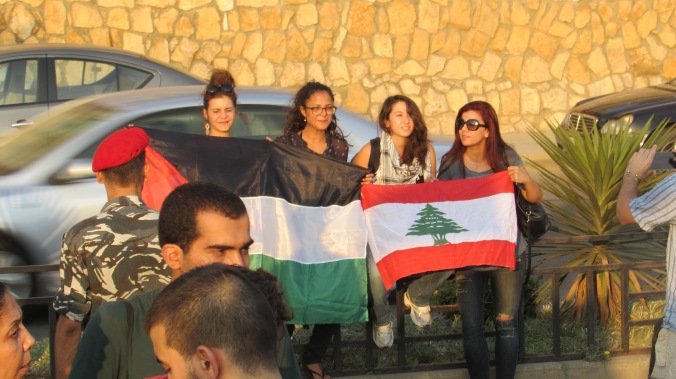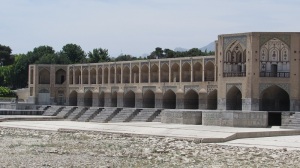The FIFA World Cup is over.  Here in Beirut, Lebanese are passionate for soccer. It’s hard not to be. Everywhere you look, from restaurants to cafes, to people’s houses and cars, you see flags of–not Lebanon–but of the major popular soccer teams, especially Germany, Brazil, Argentina, Italy and France. Following Germany and Argentina’s advance from the semi-finals to the final match, the last few days have mostly been a sea of blue and white with Argentina fans, and black, red, and yellow for the Germany fans. When Germany defeated Argentina in extra time, Lebanese poured to the streets on their motorcades waving Germany flags and shouting from the tops of their lungs. People lit firecrackers, shot their guns in the air, and celebrated in the streets
Here in Beirut, Lebanese are passionate for soccer. It’s hard not to be. Everywhere you look, from restaurants to cafes, to people’s houses and cars, you see flags of–not Lebanon–but of the major popular soccer teams, especially Germany, Brazil, Argentina, Italy and France. Following Germany and Argentina’s advance from the semi-finals to the final match, the last few days have mostly been a sea of blue and white with Argentina fans, and black, red, and yellow for the Germany fans. When Germany defeated Argentina in extra time, Lebanese poured to the streets on their motorcades waving Germany flags and shouting from the tops of their lungs. People lit firecrackers, shot their guns in the air, and celebrated in the streets
A few days ago while with my classmates here at the American University of Beirut, I commented about the sheer number of people with Germany and Argentina flags (and of course those somber, but till proud Brazil fans). I also remarked about how people care more about their World Cup than they do about Palestine–ironic, considering we are in an Arab country. Following the kidnapping and murder of 3 Israeli teens near Hebron by unknown Palestinian assailants, Tel Aviv launched a massive offensive against Hamas in the Gaza Strip that has left almost 500 dead–Most of whom, women and children, according to the United Nations. There have been more children killed than “militants”. Here, people call them “freedom fighters”. Afterall, if you don’t recognize a people’s existence, then expect resistance.
 If it’s the one cause that brings Lebanese together, it’s the Israeli-Palestinian conflict. Well, at least most Lebanese. Many Maronite Christians are still divided when it comes to Palestinian human rights, because of the Lebanese Civil War that was a consequence of the rise of Palestinian refugees into Lebanon. However the other confessional groups–Sunni, Shi’ites, Druzes, Greek Orthodox, etc. largely support the Palestinian cause. Today was a perfect example of that. The protest was held in Ramlet El Bayda, an area that straddles both north and south Beirut. Lebanese from all over the city came to unite in solidarity for the Palestinians. Apparently these occasions are rare.
If it’s the one cause that brings Lebanese together, it’s the Israeli-Palestinian conflict. Well, at least most Lebanese. Many Maronite Christians are still divided when it comes to Palestinian human rights, because of the Lebanese Civil War that was a consequence of the rise of Palestinian refugees into Lebanon. However the other confessional groups–Sunni, Shi’ites, Druzes, Greek Orthodox, etc. largely support the Palestinian cause. Today was a perfect example of that. The protest was held in Ramlet El Bayda, an area that straddles both north and south Beirut. Lebanese from all over the city came to unite in solidarity for the Palestinians. Apparently these occasions are rare.
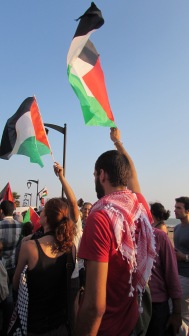 Now that the World Cup has come to an end, people are beginning to focus on Israel’s assault on Gaza. It’s strange, but heartening to be a in country where the vast majority of the people are actually on the right side of humanity. In class, we learn words like “oppression” and “resistance” while referring to the Palestinian cause without having to fear whether or not we are “offending” anyone. What is happening in Palestine is accepted as a truth here in Beirut. This is largely attributed to the fact that Lebanon experienced Israel’s full military capabilities in 2006, after Hezbollah kidnapped 2 Israeli soldiers. Israel responded by bombing Beirut–all of it, not just the south which is largely controlled by Hezbollah. Ruins from the war that left over 1,000 dead–almost a third of those believed to have been under the age of 13.
Now that the World Cup has come to an end, people are beginning to focus on Israel’s assault on Gaza. It’s strange, but heartening to be a in country where the vast majority of the people are actually on the right side of humanity. In class, we learn words like “oppression” and “resistance” while referring to the Palestinian cause without having to fear whether or not we are “offending” anyone. What is happening in Palestine is accepted as a truth here in Beirut. This is largely attributed to the fact that Lebanon experienced Israel’s full military capabilities in 2006, after Hezbollah kidnapped 2 Israeli soldiers. Israel responded by bombing Beirut–all of it, not just the south which is largely controlled by Hezbollah. Ruins from the war that left over 1,000 dead–almost a third of those believed to have been under the age of 13.
If it’s anyone who would come remotely close to understanding what the Palestinians are undergoing in Gaza, it’s the Lebanese. Even though I am closer than ever to Israel and Palestine, I have never felt so useless in helping end the onslaught of the Palestinians.  There is nothing that Lebanon can do to end the war, or to even help the Palestinians, under than helping the Palestinain refugees currently residing in Lebanon (which are treated like second-class citizens here). Most everyone here agrees that Israel is committing war crimes that are unjustifiable in Gaza. The protests express our solidarity with the people in Gaza. But they fall short in pressuring Israel to stop their “military operation”. Only in the US, where mass protests throughout the country have forced the Obama administration to demand Israel to stop the attacks do they have fruitful outcomes.
There is nothing that Lebanon can do to end the war, or to even help the Palestinians, under than helping the Palestinain refugees currently residing in Lebanon (which are treated like second-class citizens here). Most everyone here agrees that Israel is committing war crimes that are unjustifiable in Gaza. The protests express our solidarity with the people in Gaza. But they fall short in pressuring Israel to stop their “military operation”. Only in the US, where mass protests throughout the country have forced the Obama administration to demand Israel to stop the attacks do they have fruitful outcomes.
Nevertheless, the protests in Beirut are still important, and I only wish more people came. It’s one more country that disagrees with Israel’s actions and the US’ (and Egypt’s) complicity with. Pouring into the streets is one way we can express that. The World Cup is over. It’s time to take down the Germany and Argentina flags, and come together to fight for what really matters.
Check out this video of one of the protests in Ramlet El Bayda, Beirut:
